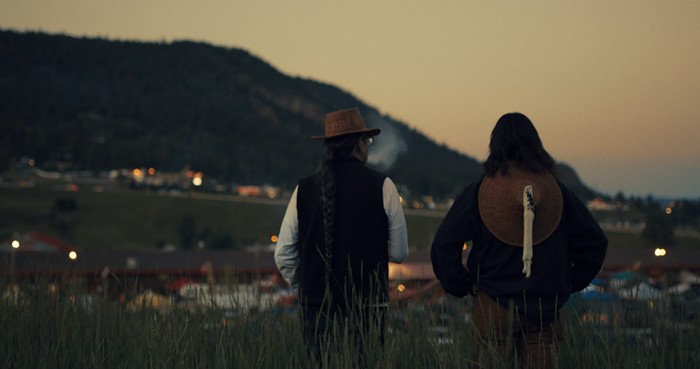St. Joseph’s Mission, an Indian residential school in Williams Lake, B.C. contains 93 unmarked children’s graves. They represent decades of abuse, systemic dehumanization, infanticide, and sexual assault against the residents of the nearby Sugarcane reservation and other Indigenous peoples in the regions. For Julian Brave NoiseCat and his father, Ed Archie NoiseCat, that history is their family’s history.
Sugarcane, Emily Kassie and NoiseCat’s investigative documentary about the abuse and violence that took place at St. Joseph’s, unflinchingly investigates previously unknown details about the school’s systemic violence, and the collaborative effort to conceal it from public view. It’s an agonizing documentary but a profoundly compassionate one, never once shying away from the truths that have long been hidden away, nor the people complicit in hiding them.
It’s the first feature film for NoiseCat, a Salish historian as well as a writer and filmmaker who lives in Bremerton, and the work is deeply personal, as his father was born at St. Joseph’s Mission. As much as Sugarcane is about those striving to repair generations of harm, it’s also a film about a father and son facing this painful history together. This wasn’t something that the director undertook lightly, but he said it was necessary to do.
“It took me a while to come around to even working on a documentary on this subject, and then to come around to participating in it in addition to directing,” NoiseCat said. “Ultimately, the reason why I chose to not only direct, but also to be a participant in the documentary, was because of the actions of others, the interest of my own father, in particular, in knowing his birth.”
NoiseCat also said he was moved by the bravery shown by Rick Gilbert, former chief of the Williams Lake First Nation, who passed away in 2023. For the film, Gilbert traveled to the Vatican and confronted a representative of the Catholic order that abused him and four generations of his family.
“That ultimately made me feel if I, the son of the only known survivor of a pattern of infanticide at St. Joseph’s Mission, wasn’t willing to go there with my family and my family’s story, I wouldn’t be giving this documentary my all. And if there was any story or documentary in the world that deserved my all, this would be it,” NoiseCat said.
For Kassie, who has a long history of investigative journalism and documentary filmmaking in newsrooms, telling this story as a feature film was uniquely important. “The camera, when wielded in the right way, can be a tool that empowers people, that gives them agency, that makes them feel like they matter, and tells them that they matter. In that way, it can really open people up and give them the strength to confront these painful truths.”
Kassie and NoiseCat eschewed typical documentary conventions like impersonal talking heads, and invited participants into the investigation itself. They had to build trust with all of those involved by showing, as a team, that they were committed to accurately telling their story.
“From the beginning, [Kassie] and our director of photography Chris [LaMarca], just signaled to people that they were going to be there, that they were going to go all the way with this story, and they were going to do it in a compassionate, heart-led way,” NoiseCat said. He said Kassie spent weeks being present in the community, including moving in with Gilbert before he went to the Vatican. “[Kassie] and Chris really built that trusting relationship, because of the patience they showed and the heart that they showed…Because we had three years to really give this thing our all, we were able to move at the pace of real human relationships and community. We didn’t have to push beyond where people were ready to go.”
NoiseCat himself benefited from their slow, deliberate approach as well. “Basically, the whole first year of filming, other than a couple exceptions, we did not film anything about my story or my family’s story because I wasn’t ready at the time, and I didn’t feel my family was ready at the time,” he says.

Julian’s father was originally resistant to exploring the family’s story, but in the film, a road trip helps the two begin to confront their history. When we get to the point in Sugarcane where NoiseCat and his family are ready to openly talk about what happened, a conversation plays as the camera captures a shot of the horizon. The filmmakers felt it was right to give space for everyone to speak openly without feeling like the camera was intruding on the conversation and, as Kassie said, “to give people a quiet and intimate space to really engage.”
As for the shot of the sky they chose to accompany the conversation, Kassie said, “To us, it looked like this open wound that was growing from dark to light. This kind of reopening.”

The film, which premiered at Sundance 2024 in January and received a special jury prize at this year’s Seattle International Film Festival, opens at SIFF Uptown tonight, August 23. As the public starts to react to the film, NoiseCat said he most appreciates Native audiences sharing how they see their own family’s story in it. “Obviously, this film needs to do important educational work for all people in North America to understand what the Indian Residential Schools and Native American Boarding Schools were, but I think it especially needs to do that kind of work in Indian Country,” he said. “The generation that survived these schools is pretty elderly at this point. It’s usually our grandparent’s generation. I don’t know if we’re ever gonna be able to truly reconcile with the government and the church that took our children and our land, but we definitely need to be able to reconcile amongst ourselves as people and as communities and as families.”
NoiseCat says that he hopes the film can be a catalyst for more investigations to take place with more institutional support given to the First Nations people doing them and then the survivors determining what reconciliation will look like. As for his own personal journey, NoiseCat said that the experience of making the film is something that he’ll always carry with him.
“I will always be grateful that I got to go on that road trip with my dad, that we were able to have some of those conversations, that he was able to have the conversation with his mom that he has in the film, and that our family, while we are not ‘free,’ so to speak, of this history of Indian residential schools, we’ve found some healing and reconciliation in the process of trying to find out what our story is and then sharing that story with others.”
Sugarcane opens Friday, August 23 at SIFF Cinema Uptown. Director Julian Brave NoiseCat will take part in a post-film Q&A following the 7:15 pm showing on Saturday, August 24.



















